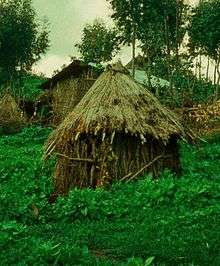Menstruation hut
A menstruation hut is a place of seclusion or isolation used by certain cultures with strong menstrual taboos. The same or a similar structure may be used for childbirth and postpartum confinement, based on beliefs around ritual impurity. These huts are usually built near the family home, have small doors, and are often dilapidated, with poor sanitation and ventilation, and no windows. The Nepali version, the Chhaupadi, is probably the best-known example, but cultural attitudes towards menstruation around the world mean that these huts exist, or existed until recently, in other places as well. The use of menstrual huts continues to be the cause of death, from exposure, dehydration, snake bite, smoke inhalation, and so on.[1] The use of these huts is illegal in some places.

Use in various cultures
According to the tradition of chhaupadi, Hindu women in western Nepal are forced to reside in a small hut, called a Chhau Goth, for 5 days during menstruation. However, the tradition requires those menstruating for the first time to stay in the hut for at least 14 days. In some communities, these huts may also be used by pregnant women to deliver babies. The huts may be made of mud and stones and may have roofs made of grass. Normally, they do not have windows, and the women must sleep on straw on the floor covering themselves with a thin blanket.[1] In a Nepali survey around 2017, one district with around 49,000 households had over 500 of these huts. The practice of using menstruation huts was made illegal in 2005 by Nepal's supreme court.
During their first menstruation, young Aborigine women in Australia live in menstruation huts built by their mother. After her period ends, she bathes in the river and the hut is burned down.
In Yap (part of Micronesia), after giving birth, women and their newborn babies spend time in a menstruation hut while the father has a holiday.
The Yurok women of California lived in menstruation huts built near the main house.[2]
In Judaism, when a woman becomes niddah (cast out during menstruation), she may remain in a niddah hut for some of the time. These huts are absent in Israel, but exist in the Ethiopian highlands. The women must stay in the hut, usually located on the margins of the village, for seven days. Women there report negative as well as positive views on the practice. Some describe fear, cold, and lack of food, while others enjoy the social interaction, relaxation, and rest. While in these huts, the women can not cook, apart from coffee and the roasting of grain. Others may bring food to them, but while doing so they take care in avoiding physical contact.[3]
The Páez people of the southwestern highlands of Colombia were known to use menstruation huts.
References
- http://www.ohchr.org/Documents/Issues/Water/ContributionsStigma/others/field_bulletin_-_issue1_april_2011_-_chaupadi_in_far-west.pdf
- Kroeber, A. L. 1925. Handbook of the Indians of California. Bureau of American Ethnology Bulletin No. 78. Washington, D.C.
- "Female Purity (Niddah) Annotated Bibliography - Jewish Women's Archive". jwa.org. Retrieved 11 January 2019.
External links

